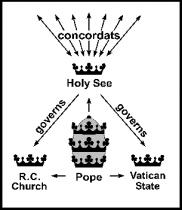Holy See
This is the government both of the Roman Catholic Church and of the State of the Vatican City. This arrangement gives the Church the privileges of a country. Nowadays concordats are made in the name of the Holy See, as this lets them shelter under international law. However, formerly they were styled as pacts between two autocrats.
 As the government of a state the Holy See makes international treaties which were formerly (and still colloquiallly) called concordats. However, naming the Holy See as a party to a concordat is a recent development. Originally, concordats were personal pacts between two absolute rulers: the pope (who is now the only absolute ruler left in Europe) and a king (called "his Catholic Majesty"). These autocrat-to-autocrat deals were later extended to various dictators.
As the government of a state the Holy See makes international treaties which were formerly (and still colloquiallly) called concordats. However, naming the Holy See as a party to a concordat is a recent development. Originally, concordats were personal pacts between two absolute rulers: the pope (who is now the only absolute ruler left in Europe) and a king (called "his Catholic Majesty"). These autocrat-to-autocrat deals were later extended to various dictators.
A few examples at the end show the pattern. As late as 1924 a concordat was made between the German state of Bavaria and the pope. And in 1966 it was made between the plenipotentiaries of the dictator of Haiti and the plenipotentiaries of the pope who, because they were fully authorised to represent their governments, could sign and ratify the concordat all at once.
It wasn't until 1957 that the Vatican began consistently calling itself the "Holy See" in the international arena.*
Examples of concordats that didn't use the modern fiction of the Holy See. These were made directly between the pope and the other country's ruler:
(1753) Concordato entre su Majestad Católica Fernando VI y el papa Benedicto XIV
(1801) Convention entre sa Sainteté Pie VII, et le Gouvernement français
(1803) Concordato fra Sua Santità Papa Pio VII e la Republica Italiana
(1851) Concordato entre Su Santidad El Papa Pio IX y Su Majestad Cristiana La Reina De España Doña Isabel II
(1860) Concordato tra Pio IX e la Repubblica di Haiti
(1862) Concordato entre el Papa Pío IX y la República de Ecuador
(1924) Concordato fra Sua Santità il Papa Pio XI e lo Stato Bavarese
(1966) Protocollo tra i Plenipotenziari di Sua Santità Papa Paolo VI e i Plenipotenziari di Sua Eccellenza Dottor François Duvalier, Presidente a Vita della Repubblica di Haiti
In other words, the "Holy See" as a concordat partner is a recent invention to take advantage of the legal priority accorded to international treaties.
* The Catholic Church at the United Nations: Church or State? Catholics for Choice, 2013, p.6. http://www.catholicsforchoice.org/topics/politics/documents/CFC_See_Change_2013.pdf
See also:
♦ The Vatican’s triple crown: church, government and state
♦ Concordats as international treaties
♦ How do concordats mesh with a country's laws? Legal experts explain







